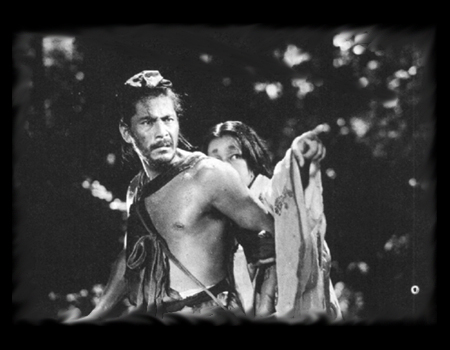Rashomon Effect:review of RashomonThe idea that every story or history has a truth. However, when looking for this truth one must take into consideration each person's background who is telling the story. For instance if a blue individual is telling of the war between the blue people and the yellow people, one should consider that it is after all a blue person telling the story and they may have a certain bent. For that matter they may have been a loyalist to the yellow cause. To know where the blue person is coming from (and hence what can be ascertained truthfully from their story) one must consider the blue person's background.
(from http://web.lemoyne.edu/museums/begieral/info.html#Anthropological)

The story told by Rashomon is both surprisingly simple and deceptively complex. The central tale, which tells of the rape of a woman (Machiko Kyo) and the murder of a man (Masayuki Mori), possibly by a bandit (Toshiro Mifune), is presented entirely in flashbacks from the perspectives of four narrators. The framing portions of the movie transpire at Kyoto's crumbling Rashomon gate, where several people seek shelter from a pelting rain storm and discuss the recent crime, which has shocked the region. One of the men, a woodcutter (Takashi Shimura), was a witness to the events, and, with the help of a priest (Minoru Chiaki), he puzzles over what really happened, and what such a horrible occurrence says about human nature.
In each of the four versions of the story, the characters are the same, as are many of the details. But much is different, as well. In the first account, that of the bandit, the criminal accepts culpability for the murder but refutes the charge of rape, saying that it was an act of mutual consent. The woman's story affirms that the bandit attacked her, but indicates that she may have been the murderess. The dead man's tale (told through a medium) claims rape and suicide. The only "impartial" witness, the woodcutter, weaves a story that intertwines elements of the other three, leaving the viewer wondering if he truly saw anything at all.
Many people watch Rashomon with the intent of piecing together a picture of what really occured. However, the accounts are so divergent that such an approach seems doomed to futility. Rashomon isn't about determining a chronology of what happened in the woods. It's not about culpability or innocence. Instead, it focuses on something far more profound and thought- provoking: the inability of any one man to know the truth, no matter how clearly he thinks he sees things. Perspective distorts reality and makes the absolute truth unknowable.All of the narrators in Rashomon tell compelling and believable stories, but, for a variety of reasons, each of them must be deemed unreliable. It's impossible to determine to what degree their versions are fabrications, and how many discrepancies are the result of legitimate differences in points-of-view. It's said that four witnesses to an accident will all offer different accounts of the same event, but there are things in Rashomon (namely, that each of the three participants names himself or herself as the murderer) that cannot be explained away on this basis. And the impressions of the "impartial" observer further muddy the waters, because, despite his protestations that he doesn't lie, we trust his tale the least.
In the end, we are left recognizing only one thing: that there is no such thing as an objective truth. It is a grail to be sought after, but which will never be found, only approximated. Kurosawa's most brilliant move in Rashomon is never to reveal what really happened. We are left to make our own deductions. Every time I watch the film, I come away with a slightly different opinion of what transpired in the woods. But not knowing remains a source of fascination, not one of frustration, and therein lies Kurosawa's greatest achievement.
another Rashomon summary, and one more review:
Forty-three years ago [1955] this writer, a US Marine stationed at Camp Fuji, while on week-end liberty, entered a darkened Tokyo theatre and watched with an all Japanese audience the new release of Akira Kurosawa's Rashomon. I have never been the same since. I contended then, and still make a case that this is one of the greatest films ever made.
From Parker Tyler "Rashomon as Modern Art"
The woman claims to have killed her husband in an irresponsible fit of horror after the rape took place; her husband claims to have committed hara-kiri out of grief and humiliation; the bandit claims to have killed him in honorable combat; and the woodcutter confirms the bandit's story while picturing the conduct of all participants quite differently from the ways they respectively describe it. As no trial of either of the living participants is shown, and as no consequent action reveals anything conclusive as to the crime, the decision as to the actual truth of the whole affair falls to the spectator's opinion. Since technically the woodcutter is the only 'objective' witness, he might seem the most reliable of the four testifiers. But his integrity is not beyond question; the version by the warrior's ghost has contradicted his version in an important detail --one inadvertently confirmed by the woodcutter's implicit admission (in an incident following the inquest) that he stole a dagger at the scene of the crime. The ghost has testified that he felt 'someone' draw from his breast the dagger with which he alleges he committed hara-kiri.
(in Donald Richie's Rashomon: a film by Akira Kurosawa pp. 195-196 (PN1997 .K8313)